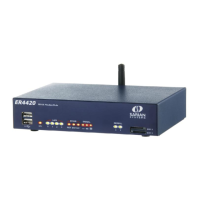Configure X.25 parameters
Digi TransPort User Guide 554
Fast select (ISDN B-channel only)
When the standard Fast select facility is requested using the F facility code, the call packet
generated by the CALL command is extended to allow the inclusion of up to 124 bytes of user
data. For example:
CALL F-1234567890DThis DATA sent with call packet
causes an X.25 CALL packet to be sent using the Fast select facility including the message
This DATA sent with call packet. The Carriage Return used to enter the command is not
transmitted. If the Fast select facility code is not included, only the first 12 characters are sent.
When a Fast select CALL has been made, the PAD accepts an extended format response from the
called address. This response, consisting of up to 124 bytes of user data, can be appended to the
returning call accepted or call clear packet. When one of these packets is received, the user data
is extracted and passed from the PAD to the terminal immediately prior to the CLR DTE . . .
message in the case of a call clear packet or CON COM message in case of a call accepted packet.
When a restricted response Fast select call has been made using the Q facility code, the call
packet indicates that a full connection is not required, so that any response to the user data in
the CALL packet should be returned in a call clear packet.
When the PAD receives an incoming call specifying Fast select, the call is indicated to the terminal
in the normal way. For example:
IC 1234567890 FAC: Q,W:2 COM
indicates that an incoming call had been received requesting Restricted response fast select and
a window size of 2. The user (or system) then has 15 seconds in which to pass up to 124 bytes of
data to the PAD to be included in the clear indication packet that is sent in response to the call.
The PAD does not differentiate between standard and restricted response Fast select on
incoming calls and, consequently, will always respond with a clear indication.
Network User Identity (NUI)
The N facility code allows you to include your Network User Identity in the call packet. For
security reasons, the PAD echoes each character as an asterisk (*) during the entry of an NUI.
Some X.25 services use the NUI field to pass both a username and password for validation.
For example, if your username is MACDONALD and your password is ASDF, a typical CALL
command would have the format:
CALL NMACDONA;ASDF-56512120
where the ; is used to separate the username from the password.
Closed User Group (CUG)
Most X.25 networks support Closed User Groups. Closed User Groups are used to restrict
subscribers to only making calls or receiving calls from other members of the same CUG. The
CUG number effectively provides a form of sub-addressing that is used in conjunction with the
NUA to identify the destination address for a call. When the G facility code is specified in a
CALL packet, it must be followed by the CUG number. This can be a 2- or 4-digit number. If you
are a member of a closed user group, the network may restrict you to only making calls to or
receiving calls from other members of the same group.
Reverse charging
Reverse charging, specified using the R facility code, allows outgoing calls to be charged to the
account of destination address. Whether or not a call is accepted on a reverse charging basis
is determined by the service provider and by the type of account held by the called user.

